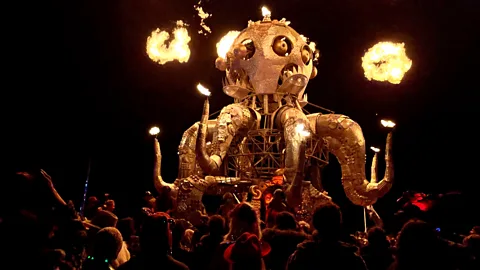As news of rising prices, intolerable weather and poor ticket sales have hit the Nevada desert event in recent years, some speculate its days could be numbered.
This weekend, tens of thousands of people will head deep into the Nevada desert to Black Rock City, a temporary metropolis that rises out of the dust every year to play host to Burning Man. For 10 days attendees – or rather, “Burners” – come together on the playa, a vast expanse of flat, inhospitable land. There are large scale art installations, mutant cars, performances, DJ sets and all manner of weird and wonderful events, from self-help talks to sex parties. Don’t call it a festival though. No money changes hands at Burning Man (instead, it’s about self-reliance and gifting), and the closest thing there is to a headline act is the event’s climax, the burning of a large wooden effigy, the “Man” himself.
If any of that sounds appealing, then you’re in luck because, for the first time in over a decade, Burning Man has failed to sell out (in previous years tickets have all been snapped up months in advance), prompting speculation that the event has lost its spark. The slow sales are the latest blow in what’s been a rocky few years for Burning Man. The event was cancelled for two years during Covid (though an unofficial “renegade burn” still drew 20,000 people to the desert in 2021). When it returned in 2022 the weather was scorching, with temperatures reaching an intolerable 100F (38C) and dramatic dust storms.
Burning Man catches a lot of people’s attention for being a hedonistic drug-fueled orgy in the desert… but there’s so much more to it – Katherine Blackler
Last year, torrential rain turned the site into a mud bath. Roads in and out of the festival were shut off and organisers told attendees to “conserve food and water, shelter in a warm space”. Some hiked for miles to get out. Diplo (who had performed a DJ set in a hot air balloon) hitchhiked out with comedian Chris Rock. There were (false) rumours of an Ebola outbreak. Meanwhile, on the internet, many seemed to revel in what was happening – with endless memes making fun of those stranded at the event and likening it to the doomed Fyre Festival. The schadenfreude was likely due to Burning Man’s increasing reputation as a hangout for wealthy “tech bros“, including Mark Zuckerberg and Elon Musk (who called it “unique to the world”). In recent years celebrities and influencers have flocked to the event.

Critics of Burning Man say that the event has strayed too far from its countercultural roots, that it’s too big, that – despite its “leave no trace” policy – it’s causing environmental damage (last year, climate activists blocked the route in). Together, all this has led to suggestions that Burning Man is experiencing something of an existential crisis. And yet, even if the numbers are down on last year, there are still hordes of people more than happy to head into the desert for the experience. “Nothing really comes close to the whole package of what is essentially a survivalist desert camping trip pretending to be an epic arts festival,” says Adriana Roberts, who has been to Burning Man 30 times.
Early roots and rituals
Burning Man’s roots go back to 1986, when two friends from San Francisco, Larry Harvey and Jerry James, dragged an 8ft (2.4m) sculpture onto the city’s Baker Beach and set fire to it to celebrate the summer solstice, with around 35 people gathered to watch. The burning of a giant figure become an annual ritual, with both the sculpture and the crowd growing each year. In 1988, 200 people were there. By 1990, the police had stepped in to say the event couldn’t take place on the beach, and the event moved to the Black Rock desert in Nevada – with members of San Francisco art collective the Cacophony Society now involved with the event.
Roberts, a DJ who for decades published an independent newspaper at Burning Man, first went in 1993. “It wasn’t this whole epic thing then,” she tells the BBC. “It was literally just going to the desert to camp with some friends for the weekend, with some kooky art shit happening. It was a lot of artists and pranksters and kind of this anarchic vibe.” There were about 800 people that year, mostly from the San Francisco area. By the next summer, attendance has doubled – and The New York Times was writing about the “irreverent arts festival and impromptu community“. In those early years, that community assembled itself in a pretty haphazard way. “It was just people randomly in the desert organising it, very guerrilla style,” says Roberts.
But with attendance roughly doubling every year, that chaos tipped over into tragedy in 1996 when a man died in a motorcycle accident leading up to the event and, in a separate incident, three young people were seriously injured when a car ran over their tent.




